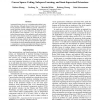Free Online Productivity Tools
i2Speak
i2Symbol
i2OCR
iTex2Img
iWeb2Print
iWeb2Shot
i2Type
iPdf2Split
iPdf2Merge
i2Bopomofo
i2Arabic
i2Style
i2Image
i2PDF
iLatex2Rtf
Sci2ools
AAAI
2011
2011
Convex Sparse Coding, Subspace Learning, and Semi-Supervised Extensions
Automated feature discovery is a fundamental problem in machine learning. Although classical feature discovery methods do not guarantee optimal solutions in general, it has been recently noted that certain subspace learning and sparse coding problems can be solved efficiently, provided the number of features is not restricted a priori. We provide an extended characterization of this optimality result and describe the nature of the solutions under an expanded set of practical contexts. In particular, we apply the framework to a semisupervised learning problem, and demonstrate that feature discovery can co-occur with input reconstruction and supervised training while still admitting globally optimal solutions. A comparison to existing semi-supervised feature discovery methods shows improved generalization and efficiency.
| Added | 12 Dec 2011 |
| Updated | 12 Dec 2011 |
| Type | Journal |
| Year | 2011 |
| Where | AAAI |
| Authors | Xinhua Zhang, Yaoliang Yu, Martha White, Ruitong Huang, Dale Schuurmans |
Comments (0)

